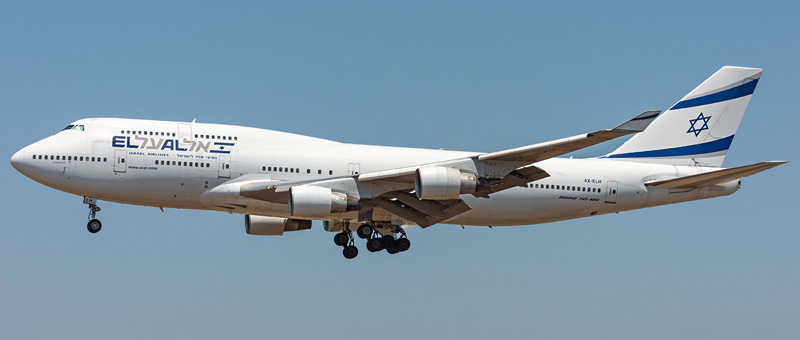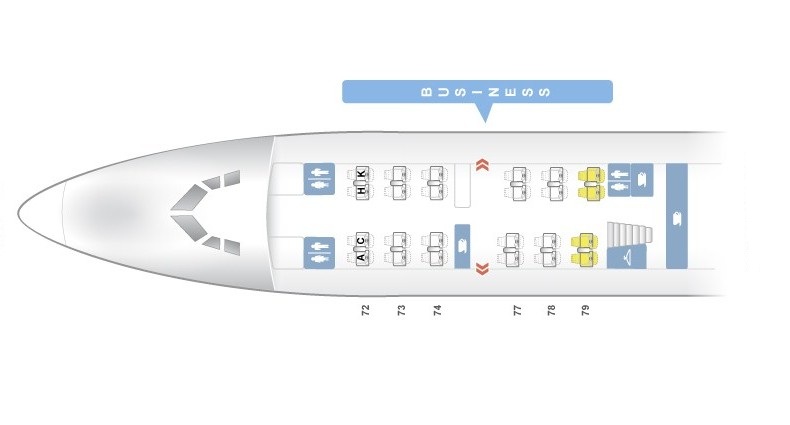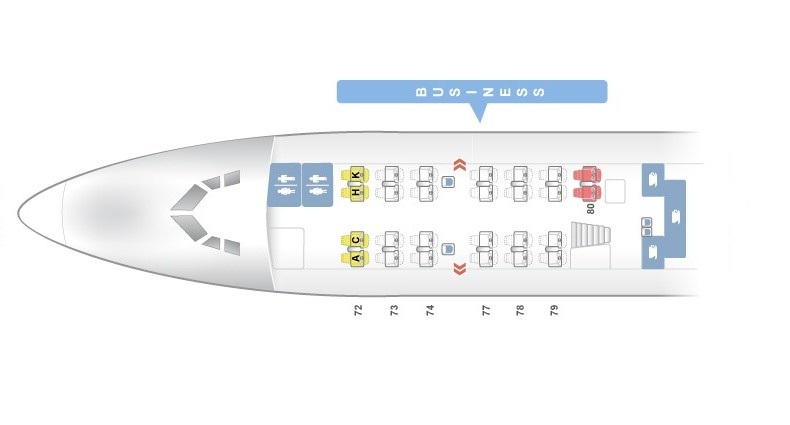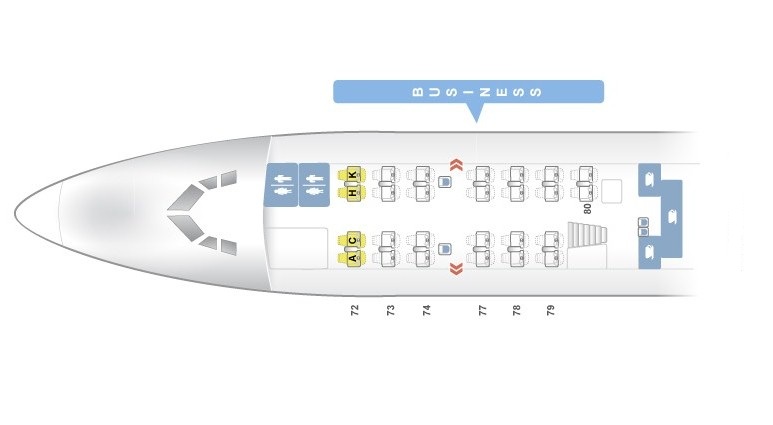
Seat map Boeing 747-400 El Al. Best seats in the plane
El Al operates 3 versions of Boeing 747-400.
First cabin version of the Boeing 747-400 (744) V1
First version of Boeing 747-400 is the most common in El Al fleet of this type of airplanes.
This airplane consists of two decks that may accommodate 405 passengers in 4 classes: first, business, economy plus and economy.

The lower deck contains seats of all 4 classes.
First 2 rows are the seats of the first class. These seats have 2-2 configuration. All these seats are standard, for passengers with infants the seats of the 2nd row have bassinets.
Behind the first class seats 4 rows of business class seats are located. There are totally 25 seats here. Passengers of the seats of the 10th row will feel comfortable thanks to the extra legroom. However, the noise from the galley and lavatories located in front of these seats will be bothersome. Lack of floor storage during take-off and landing is another disadvantage of these seats. Passengers traveling with babies are often seated here as these seats have bassinet locations.
The only disadvantage of the seats of the 13th row is close location of the lavatory.
Behind the exit row 24 seats of economy plus class are located. The seats of these class offer additional space for passengers legs, recline and other pleasance. To reserve these seats an additional charge should be paid. Due to the exit row located in front the seats of the 21st row offer extra legroom. But at the same time for the same reason the tray tables are located in the armrests making them immovable and reducing seats width a little. Among other disadvantages of these seats: proximity of the galley and stairs that lead to the upper deck, lack of floor storage during take-off and landing. For passengers with babies these seats offer bassinet locations.
Close location of the galleys may cause some discomfort to passengers of the seats C and H of the rows 22-24.
Economy class seats are divided into three sections.
First section consists of 8 rows of seats that have 3-4-3 configuration. Because of the position of the bulkhead the seats 25DEFG have limited legroom. Also in front of these seats is located galley which may be bothersome as well. As the tray tables are in the armrests, these seats are a little narrower than standard. For passengers travelling with infants these seats offer bassinets. No floor storage during take-off and landing is another disadvantage of these seats.
The seats 28 A and 28K have no windows.
The seats of the 32nd row are not reclining and are located close to lavatories.
Behind the exit row the second section of economy class seats is located. Passengers of the seats 34BC and 34HJ will take advantage of extra space for their legs. However, other passengers tend to congregate in the area of these while waiting to use lavatories and thus causing discomfort to passengers of these seats. In addition these seats are a little narrower than standard as the tray tables are built-in the armrests making them immovable and have no floor storage during take-off and landing.
The best seats of the economy class are considered the seats 35A and 35K as these seats offer extra legroom due to missing seats in front. At the same time these seats have some disadvantages: close location of the lavatories, reduced width and lack of floor storage during take-off and landing. The same disadvantages have the seats 36DEFG. Passengers with infants are often seated on these seats as they have bassinets. Extra legroom will provide additional comfort for passengers.
Limited recline and proximity of the galleys are the main disadvantages of the seats 43DEFG and of the seats of the 44th row.
The third section of economy class seats is located behind another exit row. As the tray tables of the seats 45ABC and 45HJK are built-in the armrests the width of these seats is reduced a little. The noise from the galleys located here may also represent a problem as well as lack of floor storage during take-off and landing and lack of power ports. Protrusion of the exit doors inside restricts some space of passengers of the seats 45A and 45K. Passengers of other seats of these row, i.e. the seats 45BC and 45HJ will take advantage of extra legroom.
For passengers with infants the seats 46DEFG offer bassinets. Due to position of the bulkhead the legroom of these seats is limited. Among other disadvantages of these seats: proximity of the galley, reduced width and lack of floor storage during take-off and landing.
For passengers traveling with a partner are ideal BC and HJ seats of the rows 57-60. Also these seats have additional storage space at windows side.
The main disadvantage of the seats 59DEFG is close location of the lavatories.
The seats of the last 60th row are not reclining and are located close to the lavatories what makes these seats bad seats.

The upper deck consists of 6 rows of business class seats that have 2-2 configuration and are divided into two equal sections per 3 rows in each.
Passengers of the upper deck will take advantage of more quite atmosphere because these cabin is not crowded and therefore passengers have more attention from flight attendants. Additional storage near the windows seats is another advantage.
The seats of the 72nd row have such a disadvantage as less overhead space.
The seats of the last 79th row have such disadvantages as proximity of the galleys, lavatories and stairs and lack of recline.
Second cabin version of the Boeing 747-400 (744) V2
This version of Boeing 747-400 operated by El Al may accommodate 381 passengers in four classes.

The lower deck begins with the seats of the first class. First class has 12 flat bed seats that are located in 3 rows per 4 in each. All these seats are the same without any issues.
Business class in the lower deck is represented with 24 seats. The only disadvantage of the seats of the 10th row is close location of the galleys and lavatories the noise from which may cause discomfort to passengers of these seats.
Behind the exit row 39 seats of economy plus class are located. Thanks to the exit row located in front the seats of the 21st row offer extra legroom. However, other passengers tend to congregate in the area of these seats while waiting to use lavatories. Also these seats have no floor storage during take-off and landing.
Close location of the galleys is the only disadvantage of H seats of the rows 22-24.
Due to the bulkhead position the seats 24ABC and 24DEFG have limited legroom. Proximity of the galleys and lavatories is another disadvantage of these seats.
Economy class may transport 280 passengers. First section includes 4 rows of seats that have 3-4-3 configuration. Only the seats of the 30th row have such a disadvantage location of the lavatories behind.
The second section of economy class seats is located behind the exit row. This section consists of 11 rows. Passengers with infants are often seated on the seats 34DEFG as they have bassinet locations. Due to the exit row in front passengers of these seats will feel comfortable thanks to the extra legroom. However these seats have the following disadvantages: close location of the lavatories, reduced width of the seats and lack of floor storage during take-off and landing.
Passengers of the seats 34ABC and 34HJK will take advantage of additional space for their legs as well. Among disadvantages of these seats: proximity of the lavatories, as the tray tables are built-in the armrests these seats are a little narrower than standard, also there is no floor storage for these seats during take-off and landing. Another disadvantage of the seats 34A and 34K is protrusion of the exit door that may impede the legroom.
Location of the galley behind is the only disadvantage of the seats of the 43rd row.
The third section of economy class seats consists of 17 rows. The seats of the 45th row offer extra legroom to its passengers. But protrusion of the exit doors restricts it for passengers of the window-side seats, i.e. the seats 45A and 45K. The noise from galleys will cause discomfort to passengers of the seats of this row as well as immovable armrest that reduced the seat width. In addition these seats have no floor storage during take-off and landing.
Close location to the galleys is also a disadvantage of C and H seats of the rows 46-49 and of the seats 49DEFG. The seats 49DEFG have bassinets for passengers travelling with babies.
The main disadvantage of the seats 60D and 60G is proximity of the lavatories.
Limited recline and close location of the lavatories make the seats 60BC, 60HJ and the seats of the last 61st row bad seats.

The upper deck includes 26 seats of business class. The seats are divided into two sections. First section contains 3 rows of seats that have 2-2 configuration. The only disadvantage of the seats of the 72nd row is close location of the lavatories.
The second section of business class seats is located behind exit row. There are 4 rows of seats here. First 3 rows of seats have 2-2 configuration and all these seats are standard. But the seats of the last row, i.e. the seats 80HK are considered bad seats due to proximity of the stairs and galleys.
Third cabin version of the Boeing 747-400 (744) V3
The third version of Boeing 747-400 offers seats of three classes: business, economy plus and economy.

The lower deck contains the seats of economy plus and economy class.
Economy Plus class includes 26 seats. Only the seats of the rows 11-13 have such a disadvantage as close location of the galleys and lavatories.
Economy class is located behind the seats of economy plus class and may transport 389 passengers. The seats of the economy class are divided into four sections.
First section consists of 7 rows. Passengers travelling with babies are often seated on the seats of the 14th row as these seats have bassinets. Close location of the lavatories and galleys mat represent a problem for passengers of these seats.
Limited recline and proximity of the galleys and lavatories are the main disadvantages of the seats 19ABC, 19HJK and 20DEFG.
The second section of economy class seats is located behind the exit row. Thanks to the exit row located in front the seats 21HJK offer extra space for passengers’ legs. However, protrusion of the exit door restricts these extra space for the seat 21K. Among disadvantages of these seats: proximity of the galley, lavatories and stairs that lead to the upper deck and lack of floor storage during take-off and landing.
Noise from the galleys and lavatories located nearby will be bothersome for passengers of H seats of the rows 22-24 and of the seats 24ABC, 25DEFG. Another disadvantage of the seats 24ABC and 25DEFG is limited legroom.
Other passengers tend to gather in the area of the seats of the 31st row while waiting to use lavatories and thus causing discomfort to passengers of these seats.
The third section of economy class contains 10 rows of seats that have 3-4-3 configuration. Passengers of the seats of the 34th row will feel comfortable thanks to the extra legroom. However, as the tray tables are in the armrests, these seats are narrower than standard, close location of the lavatories may cause inconvenience as well. These seats have no floor storage during take-off and landing.
Close location of the galleys is the only disadvantage of the seats of the 43rd row.
The last section of economy class have 17 rows of seats. The seats of the 45th row offer extra legroom. But proximity of the galleys, reduced width of the seats and lack of floor storage are the main disadvantages. Also the exit doors restrict extra legroom of the seats 45A and 45K.
C and H seats of the rows 46-49 and the seats 49DEFG have such a disadvantage as proximity of the galleys. For passengers with babies the seats 49DEFG offer bassinet locations.
Passengers tend to congregate in the area of the seats 60D and 60G in order to visit lavatories and causing inconvenience to passengers.
The seats 60BC, 60HJ and the seats 61DEFG are less reclining than standard and are located close to the lavatories. That is why these seats are considered bad seats.

The upper deck consists of 26 angle flat seats of business class.
These seats are divided into two sections and all of them are standard. Only the seats of the72nd row have such a disadvantage as close location of the lavatories.
Usefull information about “El Al”
- Rating and reviews about “El Al”
- Boeing 747-400 El Al. Photos and description of the plane
- El Al – company description and aircrafts fleet
